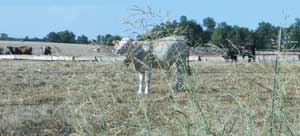Specialist: Grazing Cattle In Johnsongrass Is Common Question
MT. VERNON, MO.
Whether or not a cattle producer can let cattle safely graze pastures withjohnsongrass in them is a becoming more commonly asked question at University of Missouri Extension offices in southwest Missouri according to Eldon Cole, a livestock specialist with MU Extension.
“The question comes up due to the dry weather and the increasing presence of johnsongrass in southwest Missouri pastures,” said Cole. “There is always some risk of prussic acid poisoning with cattle grazing johnsongrass but it is minimal when the forage is over 20 to 24 inches tall.”
Here by the first of September, most johnsongrass is well over 20 to 24 inches tall and has headed out.
“The greatest risk for toxicity on species such as johnsongrass, sudan-sorghum hybrids and sudan occur in the young, succulent growth stage. It can also be risky when the plant suckers out following a frost, drought or herbicide application,” said Cole.
Cattle that have been on the pastures containing johnsongrass during the year tend to develop the ability to cope with the prussic acid.

Photo credit: MUExtension
For safety’s sake, Cole says some caution should be used when introducing naive cattle to a pasture containing any of the prussic acid bearing species.
One option, according to Cole, is to have the cattle full of hay or give them some concentrate feed before turn-in on a pasture with johnsongrass.
A second option is to not turn the whole herd in at once. Instead, use an animal or two of lesser value for test purposes and observe them for 30 to 45 minutes. Chances are they will head for the johnsongrass first.
“I also tell callers to know where your veterinarian is and have him or her on speed dial. Prompt treatment can save an animal,” said Cole.
Affected cattle will first salivate, then stagger, go down and appear to be suffocating.
Prussic acid content in hay dissipates following cutting and curing and rarely causes any problems. However, there is no simple, inexpensive, fool-proof test for prussic acid risk in a forage.
“Some veterinarians do use a test that is a subjective test, but extension specialists have not adopted that procedure,” said Cole. ∆